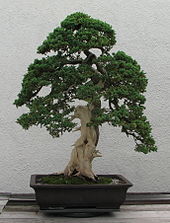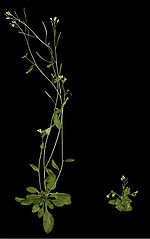- Dwarfing
-
Dwarfing is a characteristic in plants and animals whereby one or more members of a breed or cultivar are significantly smaller than standard members of their species. The effect can be induced through genetic or hormonal means.
Contents
Animals
In animals, including humans, dwarfing can occur in several ways resulting from growth hormone deficiency, genetic engineering, selective breeding, and insular dwarfism. Dwarfing can produce more practical breeds that can fit in small accommodations, as well as other associated benefits.
Plants
As with animals, plants can be dwarfed through genetic engineering and selective breeding, but can also undergo natural, morphological changes to acclimatize to environmental stresses such as soil quality,[1] light,[1] drought,[2] flood,[3] cold,[4] infection,[5] and herbivory[6] resulting in a dwarfed stature. Plants dwarfed due to environmental stress are said to be "stunted." The majority of dwarfing in plants occurs not from the damage environmental stresses inflict on them, but instead by hormones produced in response to the stress.[7] Plant hormones act as a signal to the various tissues of plants inducing one or more responses, the class of plant hormone responsible for dwarfing in plants due to injury are called jasmonates. Such responses include, but are not limited to: less frequent cell divisions[7] and reduction of cell elongation.[8]
The propagation of decorative, dwarfed plants, known as bonsai, can occur by providing artificial environmental stress.
In horticulture, dwarfing can be considered a desirable characteristic in modern orchards. This kind of dwarfing can be attained through selective breeding, genetic engineering, or more often, scions are grafted on to dwarfing rootstocks.[9] Almost all modern apples in commercial use are propagated as dwarf or semi-dwarf trees for ease of picking and spraying.
See also
References
- ^ a b Hutchings, M. J.; de Kroon, H. (1994), "Foraging in Plants: The Role of Morphological Plasticity in Resource Acquisition", Adv. Ecol. Res. 25: 159–238
- ^ http://www.physorg.com/news176993365.html
- ^ Else, M. A.; et al. (1996), "Stomatal Closure in Flooded Tomato Plants Involves Abscisic Acid and a Chemically Unidentified Anti-Transpirant in Xylem Sap", Plant Physiol 112: 239-247
- ^ Okamoto, T.; Tsurumi, S.; Shibasaki, K.; Obana, Y.; Takaji, H.; Oono Y.; Rahman, A. (2008), "Genetic Dissection of Hormonal Responses in the Roots of Arabidopsis Grown Under Continuous Mechanical Impedance", Plant Physiol. 146: 1651–1662
- ^ Scholthof, H. B.; Scholthof, K. B. G.; Jackson, A. O. (1995), "Identification of Tomato Bushy Stunt Virus Host-Specific Symptom Determinants by Expression of Individual Genes from a Potato Virus X Vector", Plant Cell 7: 1157-1172
- ^ Chouinard, A.; Filion, L. (2005), "Impact of Introduced White-Tailed Deer and Native Insect Defoliators on the Density and Growth of Conifer Saplings on Anticosti Island, Quebec", Ecoscience 12: 506-518
- ^ a b Zhang, Y.; Turner, J. G. (2008), "Wound-Induced Endogenous Jasmonates Stunt Plant Growth by Inhibiting Mitosis", PloS one 3: e3699
- ^ Swarup, R.; Perry, P.; Hagenbeek, D.; Van Der Straeten, D.; Beemster, G. T. S.; et al. (2007), "Ethylene Upregulates Auxin Biosynthesis in Arabidopsis Seedlings to Enhance Inhibition of Root Cell Elongation", Plant Cell 19: 2186–2196
- ^ http://extension.oregonstate.edu/news/story.php?S_No=975&storyType=garde
Wikimedia Foundation. 2010.


